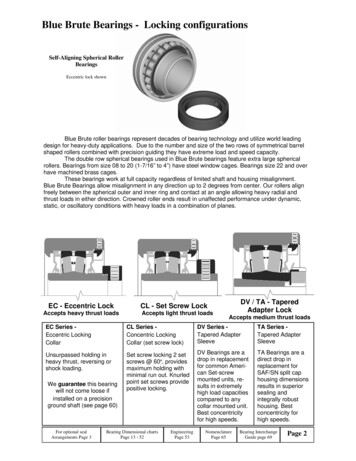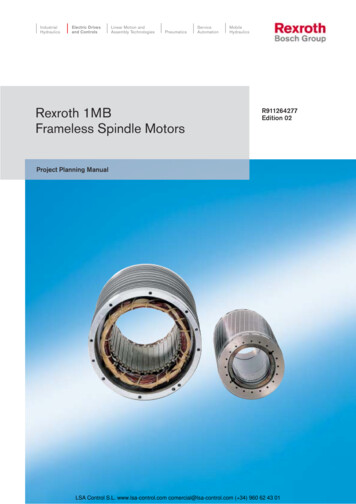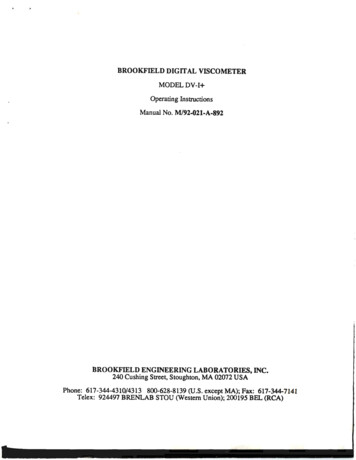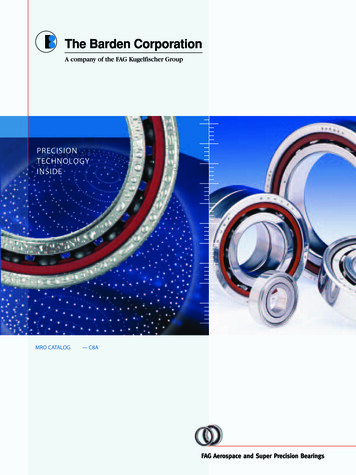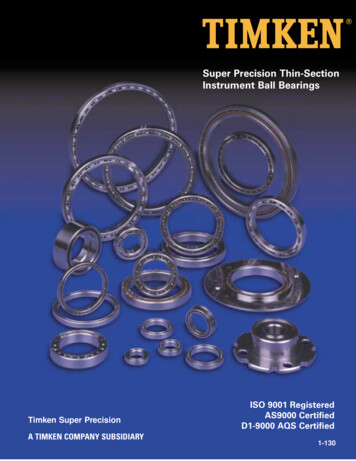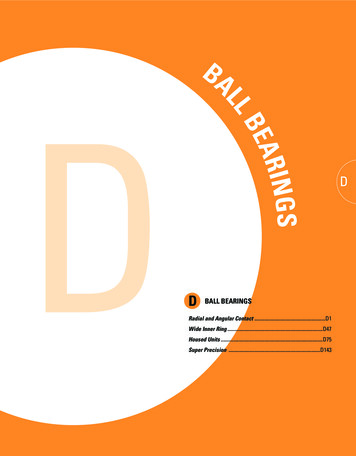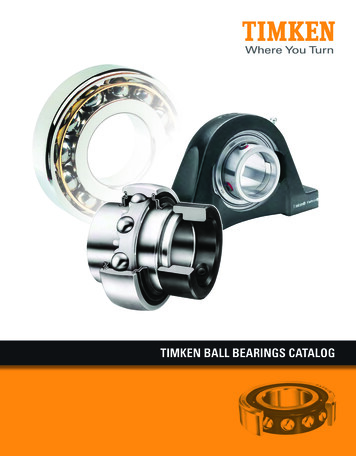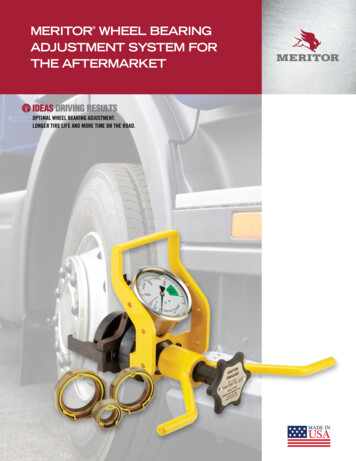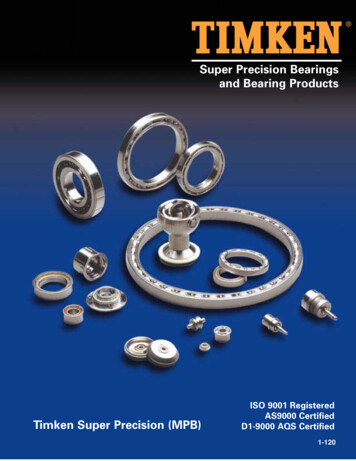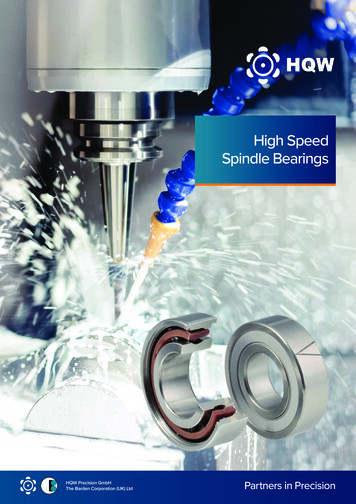
Transcription
High SpeedSpindle BearingsHQW Precision GmbHThe Barden Corporation (UK) LtdPartners in Precision
ContentsHigh Speed Spindle BearingsOur Spindle Bearings. 4Quality. 5Engineering Support. 5Spindle Bearings. 6Applications. 7Materials and ComponentsRings. 8Corrosion Resistance. 9Balls. 10Hybrid Bearings. 10Cages. 1 1Lubrication. 12Lubricant Selection. 12Grease Lubrication . 13Oil Lubrication. 14Direct Lubrication. 14Design of Spindle Bearings. 15Nomenclature. 16Contact Angle. 17Dimension Series. 17Product Tables. 18-51Ball Screw Support Bearings (ZKLN). 52Bearing Preload. 54-55Unloading Force. 56Duplex Bearings. 57Spacers. 58Precision Lock Nuts. 59-63Sizes, Tolerances and Geometric AccuracyTolerance Table - Inner Ring . 65Tolerance Table - Outer Ring. 66Mounting and Fitting. 67Calibration. 67Shaft Tolerances. 68Housing Tolerances. 69Handling of Spindle Bearings. 703
High Speed Spindle BearingsHQW Precision and The Barden Corporation (BUK)are Partners in Precision, leading the market in superprecision bearings. Working together we providecustomers worldwide with the highest quality precisionbearing products and services.Barden (BUK) brings more than seven decadesof expertise and well-established practices to thepartnership. HQW Precision was founded in 2010 andbrings state-of-the-art facilities and a fresh, modernQualityoutlook. Jointly, we are able to share best practice todeliver high-end bearings and assemblies, tailormade tothe demands and requirements of our customers.Our products are manufactured to the highest qualitystandards and we are also able to offer a full range ofengineering support services. We pride ourselves onhaving a fast and flexible mindset which is rooted in allareas of the business.As a premium manufacturer, we place the utmostimportance on the quality of our production processes.The tolerances for size, geometry and running accuracyof our spindle bearings fully comply with international ISO492 and national DIN 620 standards, as well as AmericanABEC tolerance classes. Our bearings are fitted with ballswhich meet the highest tolerance standards, ‘Grade 5’ asa minimum, and our spindle bearings are manufactured toISO P4S as standard and up to P2 where required.Customers are assured of exceptional high-quality andprecision as there is full traceability of our product whenneeded; from initial enquiry, through the design processand manufacturing. We have world leading systemsand processes in place: our site in Plymouth (UK) is fullycertified to aerospace standards AS9100 and AS9120 formanufacturing and distributing flight critical componentsfor the aviation and space industries, and our site inKürnach (Germany), is certified to ISO 9001:2015 forquality and process management.After assembly in a Class 7 cleanroom our bearingsare subjected to 100% noise testing to ensure that ourcustomers always receive bearings which meet the bestnoise standard for their application. The overall result is ahigh precision product with a long operating life.Engineering SupportWe are a global development and service partner forour customers worldwide. In addition to offering experttechnical advice, we have state-of the-art laboratoryequipment and test rigs which are used for bearinganalysis and testing.As well as basic bearing analysis, our team of bearingspecialists also offer the following:HQW Precision plant, Kürnach, GermanyBarden UK plant, Plymouth, United Kingdom Our Spindle BearingsWe specialise in the production of spindle ball bearingswhich are manufactured to the highest tolerancestandards. Our product range covers bearings from3mm inner diameter up to 120mm outer diameter. Thebearings are specially designed to offer an exceptionallylong lifetime, extreme corrosion resistance whererequired and are suitable for the highest operatingspeeds. Bearing lifetime calculations and evaluation ofkinematics.Rigidity and preload design.Thermal inspection.Shaft calculation.Lubricant recommendation.Services offered by our laboratory: Bearing damage analysis.Grease analysis.Dimensional check.Friction measurement.Product quality is of utmost importance, and a Class7 cleanroom is an integral part of our manufacturingprocess. Our flexible approach in manufacturingcombined with a large stock of different product typesmeans we can fully meet the demands of our customersat all times and deliver product quickly.45
Spindle BearingsApplicationsSpindle bearings are single row angular contact ballbearings which are designed for the highest speeds andhighest load ratings. They support thrust loads in onedirection, and at very high speeds can simultaneouslyabsorb high radial forces and single direction axial forces.These bearings typically have one open shoulder onthe outer ring as standard. This design allows a largerball complement than found in comparable deep groovebearings, giving a greater load capacity. They also includea window cage to maximise the bearing’s speed, and theyhave exceptional high running accuracy.The spindle bearings have a nominal contact angle of 15 or 25 . They can be used in pre-loaded duplex sets, backto back (DB) or face to face (DF) for supporting thrustloads in both directions or in tandem (DT) for additionalcapacity.No friction or wear due tofluoroelastomer (FPM) non-contactseals both sides.Balls are made of stainless steelor chrome steel as standard.Silicon nitride (ceramic) balls canbe used and permit a significantincrease in speed.Spindle bearings are predominantly used in machinetool spindles. They are specially designed to handlethe demanding operating conditions of the application.Depending on the size and type of material beingmachined by the spindle, the bearing has to cope with avariety of machine speeds, offering maintenance-free andreliable performance.Modern grinding motor spindles reach speeds of up to180,000 rpm. Running accuracy and quietness are keyrequirements in this application. These conditions are metby ensuring that all rotating components are very finelybalanced and that the bearings meet the highest qualitystandards. Our bearings meet these requirements downto the last micron.Our spindle bearings are suitable for a variety ofapplications including motorised spindles, belt drivenmechanical spindles, and specialist applications suchas rotary unions for machine tool spindles. In this case,cooling liquids are supplied through the rotating spindleshaft at pressures of up to 150 bar and at high operatingspeeds, which places extreme demands on the bearingin terms of high speed and increased axial loads.Our bearings provide excellent performance in theseconditions.Operating TemperatureStandard spindle bearings can be used at temperaturesup to 120 C due to the limiting temperature of thephenolic resin cages and high-speed grease. Othermaterials can be specified for higher temperatureenvironments, please contact our EngineeringDepartment for more information.A higher number of ballscontributes to higher loadratings.Rings are made from a varietyof stainless and carbon chromebearing steels.Contact angles of 15º and 25ºpermit significantly higher axialforces and improved rigidity.Window cage made of reinforcedphenolic or high performanceplastic for special applications.High performance lubricantsensure high speeds and a longlifetime.67
Materials and ComponentsCorrosion ResistanceThe components of the bearing design will vary according to the application and choices should be based onanticipated operating conditions.Corrosion can be described as the degradation ofmaterial surface through reaction with an oxidisingsubstance. In engineering applications, corrosion is mostcommonly presented as the formation of metal oxidesfrom exposure to air and water from the environment.Design choices include: Materials (rings and balls).Cages.Lubrication.Internal design parameters.Preloading (Duplexing).Tolerances & geometric accuracy.Closures.In most spindle bearing applications corrosion resistanceis not an essential characteristic of the bearing material,with 100Cr6 used extensively. However some applicationsare required to work in aggressive environments wherecorrosion resistance is essential.In controlled salt-spray tests (according to DIN ENISO 9227:2012), our SV30 bearings have proven togive superior corrosion protection compared to thosemanufactured from stainless steels such as X65Cr13and 100Cr6. During testing, the concentration of thesalt solution, the temperature, the pressure, and the pHvalue were all maintained at a constant level. Thanks toits higher chrome content, X65Cr13 stainless steel willcorrode at a much slower pace than 100Cr6.The graph below shows the degree of corrosion overtime for three materials, and SV30’s high corrosionresistance is clearly seen on the test rings.Please consult our bearing specialists for particular requirements.Stainless steel X65Cr13 and bearing steels 100Cr6 (SAE 52100) are standard materials used in this application. Theyhave good load carrying capacity, fatigue resistance and stability.The high-performance stainless-steel material SV30 (X30CrMoN15-1, AMS 5898) can also be specified. This highlyrefined material has a very fine grain structure which enhances its mechanical properties. It also provides excellentcorrosion resistance, fatigue resistance and stability.CorrosionRingsThe composition of these materials is shown in the table below.DesignationMaterial 65Cr131.4037S12.50-14.500.43-0.50 1.00 1.00 0.040 5-0.45 0.025 0.025--Time (h)Corrosion over timeMaterial CompositionAdvantages of SV30 8Longer lifetime in comparison to conventional materials.Exceptional corrosion resistance.Improved mechanical properties due to very fine structure.Low noise.Standard temperature resistance to 150 C; with special heat treatment up to 400 C.High chemical resistance.Excellent emergency running capabilities when used in conjunction with ceramic balls.100Cr6after 50hX65Cr13after 200hSV30after 1000hIf the application demands a particularly low corrosion rate we recommend the use of SV30 steel, which showed onlyslight signs of corrosion after 1,000 hours of salt spray testing.9
BallsCagesFor 100Cr6 bearings the standard ball material is thesame as that used for the raceways, whereas for SV30bearings the balls are made from X65Cr13 as standard.However, for particularly arduous applications many ofour bearings are fitted with ceramic balls made fromsilicon nitride (Si3N4). Only balls of grade 3 and 5 areused for our spindle bearings as these classes complywith the highest tolerances in terms of size, roundnessand roughness.Proper selection of cage design and materials is essentialto the successful performance of a precision ball bearing.The basic purpose of a cage is to maintain uniform ballspacing, to prevent them coming into contact, thusensuring an even load distribution within the bearing.They can also be designed to reduce torque andminimise heat build-up.Our spindle bearings have a window cage made of fabricreinforced phenolic as standard. If required, cages canalso be produced from high-performance plastics suchas PEEK or Polyamide-imide (such as Torlon ). Thesematerials are used on account of their low weight, theircorrosion resistance and low friction, which results inreduced wear and less heat generation. This enables thebearings to operate at higher speeds while prolonginggrease service life.Hybrid BearingsHybrid spindle bearings are used to meet therequirements of particularly demanding applications.The inner ring and outer ring are made of either 100Cr6or highly wear-resistant SV30 steel, while the balls areceramic (silicon nitride).Cage TypesShortDesignationTATBCeramic balls used in place of steel balls can radicallyimprove bearing performance in several ways: Standard cage type. Oil impregnation possible. Suitable for spindle ball bearings withhigh accuracy. High strength. Good low lubricant runningcharacteristics.TAHigh running speeds. Ceramic hybrid bearings run atsignificantly lower operating temperatures, allowingrunning speeds to increase by up to 50% (as shownopposite).Machine-made single-piece window cagemade of fabric reinforced phenolic resin.(Outer ring guided only) As standard TA cage, plus: Bore grooves to reduce friction andimprove lubricant circulation. Typical cage design for 7000, 7200series from bore size 5 (25mm) andabove.Low wear and long operating life. Bearings withceramic balls have been proven to last up to five timeslonger than conventional steel ball bearings. Theinherent properties of silicon nitride mean the ballsdrastically reduce the predominant cause of surfacewear in conventional bearings. Lower operatingtemperatures also help extend lubricant life andthey provide excellent performance where there isinsufficient lubrication.Please consult our bearing specialists for moreinformation on how hybrid bearings can improveapplication performance.Machine-made single-piece window cagemade of fabric reinforced phenolic resin.(A outer ring guided,B inner ring guided)Features Very high speeds.Low vibration and noise. Vibration levels can be upto seven times lower than conventional steel ballbearings. This is because ceramic balls are 60%lighter than steel balls and because their surface finishis almost perfectly smooth.Systems equipped with ceramic hybrids show higherrigidity and higher natural frequency making them lesssensitive to vibration.Cage TypeTxATxBMachine-made single-piece window cagemade of high-performance plastic (PEEK,Polyamide-imide, etc.).(A outer ring guided,B inner ring guided,x material) For spindle bearings with very highspeeds.Machine-made single-piece window cagemade of high-performance plastic (PEEK,Polyamide-imide etc.) with a pitch for betterguidance in outer ring and higher speeds.(A outer ring guided,x material) For spindle bearings with very highspeeds.Hybrid BearingsSteelTxAF50,000 rpm100,000 rpm150,000 rpmLimiting speed for hybrid spindle bearings (illustrative) High strength. Best low lubricant runningcharacteristics. Also suitable for high temperatureapplications (operating temperature ofpolyamide-imide (such as Torlon ) up to260 C). High strength. Best low lubricant runningcharacteristics. Also suitable for high temperatureapplications (operating temperature ofPolyamide-imide (such as Torlon ) up to260 C).Cage types1011
LubricationGrease LubricationGood lubrication is critical to the performance of antifriction bearings. Increased speeds, higher temperatures,improved accuracy and reliability requirements resultin the need for closer attention to lubricant selection.Lubricant type and quantity have a marked effect onfunctional properties and service life of each application.A good lubricating film:The main task of a lubricant is to form a hydrodynamiclubricating film between the rolling element and theraceway, thereby preventing direct contact between thefriction surfaces of the individual components. Reduces friction.Minimises wear.Protects against corrosion.Dissipates heat from the bearing.Acts as barrier to contaminants.Lubricant SelectionThe lubricant type is typically selected according to theoperating conditions and limitations of the applicationwhile taking into account specific customer requirements.The most significant factors in selecting a lubricant are: Viscosity of the lubricant at operating temperature.Maximum and minimum allowable operatingtemperatures. Operating speed. Required friction values.Lubricants are available in two basic forms: Oils (fluid lubricants).Grease lubrication is characterised as oil, bound by a thickener which is continuously dispensed to the contact pointduring the lifetime. The primary advantage of grease over oil is that bearings can be pre-lubricated with grease,eliminating the need for an external lubrication system.Our sealed spindle bearings are lubricated with a high-performance grease for the entire lifetime, and attainablerunning speeds are generally lower compared with oil lubrication.The bearing grease is based on synthetic oil and polyureathickener as standard. The grease exhibits optimalperformance during tests at speed factors of two millionn·dm (speed x PCD of balls). Bearing run-in occurs muchfaster and the starting torque is greatly reduced.Grease lubrication also requires less maintenanceand has less stringent sealing requirements than oilsystems. Grease tends to remain in proximity to bearingcomponents, metering its oil content to operating surfacesas needed.Other considerations to grease selection include:Greases – solid to semi-solid products consisting of anoil and a thickening agent. More than 300 different greases and oils are available forthis purpose. Speedability.Temperature.Consistency (stiffness).Bleeding.Advantages of Sealed SpindleBearings with Grease Lubrication Lifetime lubrication.Maintenance-free.No external lubrication system required.Optimal grease quantity.Use of a high-performance lubricant (speed factorn·dm 2,200,000).Greasing, sealing and packaging in a clean roomClass 7.Factory pre-lubrication of bearings is highly recommended, since the correct quantity of applied lubricant can be asimportant as the correct type of lubricant. This is especially true of greases, where an excess can cause high torque,overheating and — if the speed is high enough — rapid bearing failure. Based on our vast experience in this field, wehave established standard quantities of lubricants that are suitable for most applications.In grease lubricated bearings life is often not determined by the internal design, fitting and specification of the bearingbut by the grease itself. It is important for this reason to ensure appropriate running conditions to optimise usefulgrease life.In addition, we can offer special finishing of the spindle bearing itself or its individual components. This could include,for example, vacuum impregnation of the cage, special coating of the rings and dispersion greasing.Grease DistributionBefore operating under load, spindle bearings withlifetime lubrication first need to be run in to distribute thegrease evenly. This distribution process should be carriedout at intervals with pauses at rest, so that the oil can flowback into the track.The procedure for grease distribution is as follows:Three process steps with increasing speeds (0 .4 xnmax; 0 .8 x nmax; nmax) in relation to the maximum speedof the application, and five intervals composed of one30-second run and a two-minute stop. It is recommendedto monitor the temperature and continue the last iterationwith max. speed, longer run procedures and shorter stopsuntil a steady temperature is reached.12Run In IntervalsSpeed0.4 x nmax0.8 x nmaxnmax30s 2min30s 2min30s 2minRunStopGrease Distribution13
Oil LubricationDesign of Spindle BearingsOil lubrication can offer advantages when comparedwith grease lubrication, particularly in the case of spindlebearings rotating at high speed.a significant cost-saving effect for the end user. If regularrelubrication of the bearings is necessary, an external oilair lubrication system can be integrated into the system.Our open spindle bearings are supplied oil lubricatedas standard. In contrast to lifetime lubrication, if losslubrication is intended, the bearing must be lubricatedregularly with exactly the right amount of lubricantin order to achieve the expected bearing life. Therelubrication interval may vary widely - from a continuoussupply to every two years for example. The optimisationof relubrication intervals and lubricant quantity can haveOil-air lubrication or oil minimum quantity lubrication(MQL) is often used in modern machine tool spindlesand is shown in the diagram below. In this process, anoil film is formed in front of the spindle and conveyed tothe bearing. It enables exceptionally high speeds to beachieved and dissipates heat from the bearing. Ideallyeach bearing has its own oil-air supply.OilOpen DesignOpen spindle bearings make optimum use of theinternal space by allowing large balls and a windowcage. This results in maximum load carrying capacitiesand therefore maximum bearing life. This opendesign is recommended for oil lubrication, as it allowsrelubrication using spacers. Contamination should beprevented from entering the bearing and continuousrelubrication should be used.Sealed DesignAirSeals exclude contamination, contain lubricants andprotect the bearing from internal damage duringhandling.Open DesignOur sealed spindle bearings typically have non-contactseals on both sides, which ensure good protectionagainst contaminants, such as dust, which coulddamage the internal workings of the bearing. Thisdesign also limits lubricant leakage from the bearing.They are recommended for applications where lifetimegrease lubrication is required or where air flow throughthe bearing is present.Since the seals are non-contact there is no negativeeffect on friction or speed ratings. Our seals are madeof fluoroelastomer as standard, which can withstandpeak temperatures of 230 C, and the materialpossesses a very high resistance to grease and mineraloil.Smaller balls are typical in a sealed design allowingfor higher speeds. Further advantages of the sealeddesign include ease of handling and trouble-freeinstallation, making it particularly suitable wherebearings are being replaced.Sealed DesignOil - Air LubricationOil minimum quantity lubrication (MQL)Special Design - ACIAs a general rule, spindle bearings have an openshoulder on the outer ring (ACO). However, forsome special applications the open shoulder can bepositioned on the inner ring (ACI) (e.g. dismountablebearings). Our engineers are happy to discuss specificrequirements.Direct LubricationFor high speed spindle applications, many bearing typescan be supplied with radial lubrication holes to position oilin close proximity to the ball to raceway contact zones.The number and size of the lubricating holes can be variedto suit the application, and these holes are connected by aradial oil distribution groove. O-rings on either side of thedistribution groove prevent losses, ensuring the correctquantity of oil is delivered to the correct area.Please contact our engineers for further detaills andavailability.ACOACIDirect lubrication1415
NomenclatureContact AngleBall MaterialRing Material-100Cr6 (for 100Cr6 rings)-X65Cr13 (for X30CrMoN15-1 rings)HYQSi3N4-100Cr6SVX30CrMoN15-1Contact angle is the nominal angle between theball-to-race contact line and a plane through the ballcentres, perpendicular to the bearing axis. Load istransmitted from the shaft via contact angle (α) tothe inner ring, then via the balls to the outer ring. Toensure an even load on all bearings within a system,they should all have the same contact angle.Angular contact bearings are assembled to a constantcontact angle by varying the radial clearance. Ourspindle bearings are available with a contact angle of15 or 25 . The larger the angle, the higher the axialcapacity and rigidity as axial forces can be absorbed.Conversely, bearings with a smaller contact anglehave better radial capacity and rigidity and are able tooperate at higher speed. Deviating contact angles areavailable on request.See page 8SeriesDimensions according to ISO 15Contact AngleαC15ºAC25ºInternalGeometrydDeviating inner ring ø (e.g. d3)DDeviating outer ring ø (e.g. D7WDeviating width (e.g. W4)-Without seal2VZBoth sides, non-contact FPM(fluoroelastomer)ACOOne shoulder on outer ringACIOne shoulder on inner ringTATBOuter ring guided, phenolic resinInner ring guided, phenolic resinSealVersionCageα 15ºDimension SeriesThe nomenclature diagram opposite shows howthe spindle bearing part number is derived from thebearing’s components, tolerance classes and design.Our spindle bearings range from 3mm inner diameterto 120mm outer diameter and the following tablesindicate the dimensions, the dynamic and static loadrating and the limiting speed for the various designsof bearing. The diagram opposite shows the areaswhich are referred to by the abbreviations d, D and B.See page 11AccuracySpecificCalibrationType ofPairingP4SAccording to DIN 620See page 64-66XSee page 67UUniversalDBBack-to-back arrangementDFFace-to-face arrangementDTTandem arrangementMost bore diameter sizes have a number ofF-F (7 : 1)progressively increasing series of outside diameters,width and ball size. The diagram below shows thedifferent dimension series with a fixed bore diameterof 6mm. These series are termed 776, 786, 796, 706and 726 and are shown in the product tables.Bearing Sets - 2UL, 3UL, 2DT.Bearings are packed as sets with alignedbore and outer diameterPreloadLubricationLLightMMediumSHeavyAll bearings are supplied with highperformance lubricants, either grease(sealed bearings) or oil (open bearings).α 25ºFDimension abbreviations776786796706726776786796706726FSee pages 12-1416Dimension series for 6mmfixed bore17
Spindle Bearings - Product meterStandardWidthdDB[mm][mm]SV773 C TA3HYQ SV773 C TA3SV773 AC TAHYQ SV773 AC aled723774784*Limiting SpeedDynamicStaticαCC0[mm][ ][N][N][min ]6215215606215215423622520636225206SV783 C TA37215295HYQ SV783 C TA37215295SV783 AC TA37225285HYQ SV783 AC TA37225285SV793 C TA38315HYQ SV793 C TA383SV793 AC TA383Basic Part NumberPreload Fva / Axial R
bearing products and services. Barden (BUK) brings more than seven decades of expertise and well-established practices to the partnership. HQW Precision was founded in 2010 and brings state-of-the-art facilities and a fresh, moder
